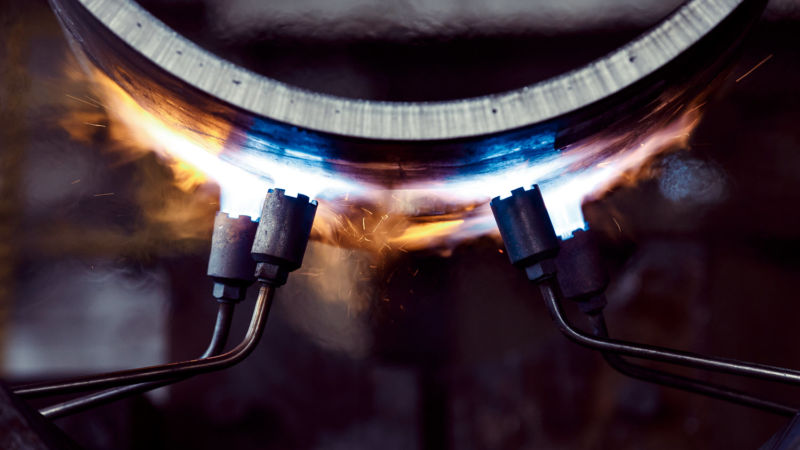Applications to Heat Treatment
Predict the following as a function of chemistry and process variation:
Application Examples
Carbide Formation During Carburization Heat Treatments
Carburization is a surface-hardening technique in which carbon is added to the surface of steel at temperatures generally between 850 °C and 950 °C. The case depth of carburized steel is a function of carburizing time and the available carbon potential at the surface. When prolonged carburizing times are used for deep case depths, a high carbon potential produces a high carbon content at the surface, which may result in excessive retained austenite and/or the precipitation of carbides. Both of these have adverse effects on the distribution of residual stress in the case-hardened part. Consequently, a high carbon potential may be suitable for short carburizing times, but not for prolonged carburizing.
The Add-On Diffusion Module (DICTRA) can be used to predict: (i) the carbon profile and case depth as a function of chemistry, time and distance, and (ii) the formation of precipitate carbides, as illustrated in this figure for a martensitic stainless steel.

Precipitation of Cr-rich Carbides in Stainless Steels
Stainless steels can be susceptible to an intergranular corrosion phenomenon known as sensitization. Sensitization occurs when Cr rich M23C6 carbides precipitate at the grain boundaries. This reduces the local Cr concentration in the matrix adjacent to the precipitate, reducing the corrosion resistance locally. Time-Temperature-Precipitation (TTP) diagrams are useful for both alloy and process selection, to avoid extensive precipitation of M23C6.
This figure shows a calculated TTP diagram for 316L, calculated using the Precipitation Module (TC-PRISMA) in Thermo-Calc. At the nose of the curve, M23C6 needs at least a few minutes to form. This indicates reasonable resistance to sensitization, as a weld or a solution heat treatment could be cooled fast enough to avoid M23C6 precipitation.

Learn more about Applications to Heat Treatment
Coupling TQ-Interface with Precipitation Models for Gas Turbine Applications
Several examples showing how Thermo-Calc can be applied to industrial heat treating.
Understanding the Influence of Alloy Chemistry on Heat Treatment Process Windows
The importance of steel chemistry and thermal history on the sensitization behavior in austenitic stainless steels: Experimental and modeling assessment
Predicting the Effects of Composition Variation for Heat Treatment of Aerospace Alloys
Application of finite element, phase-field, and CALPHAD-based methods to additive manufacturing of Ni-based superalloys
Modeling Precipitation Kinetics During Heat Treatment with Calphad-based Tools





